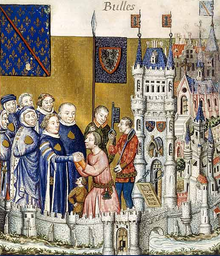Clermont, Oise
History

Clermont was also known as Clermont-en-Beauvaisis or Clermont-de-l'Oise. The town is built on a hill surmounted by a 14th century keep. It is the relic of a fortress that was later used as a penitentiary for women. The church dates from the 14th to the 16th centuries. The hôtel-de-ville, built by King Charles IV, who was born in Clermont in 1294, is the oldest in the north of France.
The town was probably founded during the time of the Norman invasions, and was an important military post, during the middle ages. The counts of Clermont-en-Beauvaisis first appeared in the early 11th century. King Philip II of France bought the county in 1218 and added it to the French crown. It was first granted as an appanage in 1218 to Philip Hurepel. With the extinction of his line, it was granted in 1268 to the House of Bourbon and was confiscated with the Duchy of Bourbon in 1527. It was repeatedly taken and retaken by the contending parties during the Hundred Years' War, and the Wars of Religion, In 1615, Henry II, prince of Condé, was besieged and captured there by the marshal d’Ancre.
Population
Graphs are unavailable due to technical issues. Updates on reimplementing the Graph extension, which will be known as the Chart extension, can be found on Phabricator and on MediaWiki.org. |
| Year | Pop. | ±% p.a. |
|---|---|---|
| 1968 | 8,437 | — |
| 1975 | 8,576 | +0.23% |
| 1982 | 8,628 | +0.09% |
| 1990 | 8,934 | +0.44% |
| 1999 | 9,699 | +0.92% |
| 2007 | 10,612 | +1.13% |
| 2012 | 10,862 | +0.47% |
| 2017 | 10,147 | −1.35% |
| Source: INSEE | ||
Sights
- Church St Samson (12th, 14th and 16th centuries) containing numerous Painting from the seventeenth century
- Dungeon of Clermont, 12th century
- fortified town hall, 14th century
- Subprefecture, 15th century
- Lardieres chapel, 17th century
- Chatellier Park
International relations
It is twinned with:
See also
- Communes of the Oise department
- List of counts of Clermont-en-Beauvaisis
- Artist Seraphine Louis, 1888-1942
References
- ^ "Répertoire national des élus: les maires". data.gouv.fr, Plateforme ouverte des données publiques françaises (in French). 2 December 2020.
- ^ "Populations de référence 2022" (in French). The National Institute of Statistics and Economic Studies. 19 December 2024.
- ^ INSEE commune file
- ^ Chisholm, Hugh, ed. (1911). . Encyclopædia Britannica. Vol. 6 (11th ed.). Cambridge University Press. p. 498.
- ^ Population en historique depuis 1968, INSEE